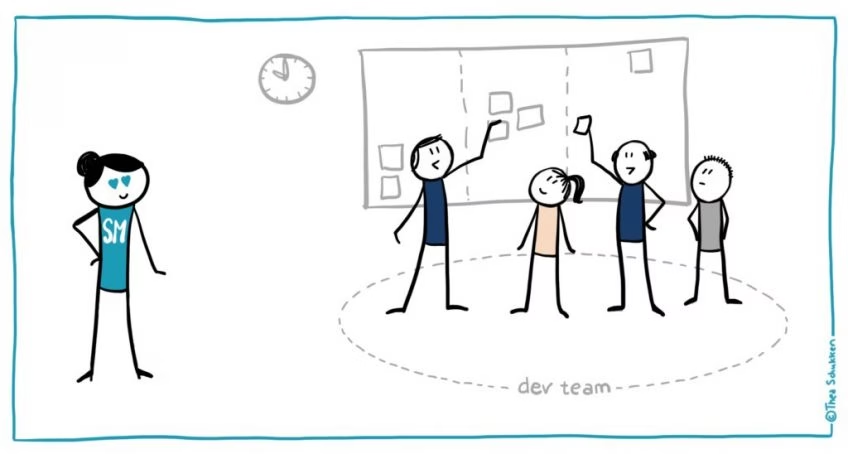
How to Build a Scrum Development Team?
Interested in building a Scrum development team?
You've come to the right place.
Scrum teams build great software products. Let's see how you can build one for your software development project.
Building a Scrum Development Team
To start to hire remote developers to build an efficient Scrum team, first, you should understand different roles for scrum development so that you can hire accordingly.

Get a complimentary discovery call and a free ballpark estimate for your project
Trusted by 100x of startups and companies like
Scrum development team roles
A scrum development team has scrum-specific roles. You shouldn't confuse these with functional roles such as those of a developer, tester, business analyst, etc. The scrum-specific roles are the following:
Product Owners (POs):
Product owners (POs) champion the software product or solution. They manage the product aims to ensure the final project achieves its goals/purpose. There must be a smooth flow of information between the PO and the development team.
The digital producer or (DP) takes responsibility for this information exchange.
Scrum Master:
Scrum masters initiate/maintain agile scrum methodology in the scrum team. They take responsibility to ensure that the team follows the agile scrum principles and practices. Naturally, any project team faces show-stopper issues, problems, and other distractions. Scrum masters resolve these issues.
The scrum master guides the team through each sprint by scheduling work, facilitating meetings, and ensuring good inter-team communication. Read more about the scrum master role in “The Building Blocks of Agile Practice”.
Scrum team - Also known as the development team:
A scrum team is a cross-functional team that works on developing the product and its features during each sprint. In scrum development, they also help to identify the complexity of each task, so have an input into how the sprint is undertaken.
Following the principles of self-organization, the team allocates a set of factors including the number of developers required and a timeframe for completion of each task.
They work together towards a common goal. This cross cooperation helps to eliminate delays in finishing each sprint and ultimately the product.
Read more about these scrum development team roles in “Scrum Roles - The Scrum Team”.
Essential qualities in a scrum development team

When you build a scrum development team, you need to look for the following qualities and skills:
- Ability to work as pair-programmers: Two developers should be able to work together on one workstation. While one writes the code, the other reviews. The roles are interchangeable.
- Automated unit testing skills: The reason you are building a scrum team is that you will probably have a complex project with multiple sprints that you need to develop on time and on budget. Heavy dependence on manual testing will slow down most of your sprints. Hence, automated, script-based testing is important.
- Code refactoring: Prepare for lots of sprints. If the code is complex, enhancing it with new functionalities during the next sprint will be hard work. Hence, a team should ideally start with as simple a code as possible. While this is desirable, exceptions are inevitable. In some sprints, the code will need to be complex, especially if the feature the team is developing is a multilayered solution. Refactoring is a process of simplifying code, without impacting functionality. The team needs to have this skill. You can read about the importance of refactoring in this Scrum guide titled "Scrum Development Team”.
- Continuous integration: During every sprint, you undertake a new build. There can be multiple builds undertaken at once. This requires good DevOps continuous skills. The compilation, execution of the unit test, and source control should be integrated and automated. Read “Continuous Integration in DevOps” to understand the importance of this skill.
In addition to these points, team members must be self-motivated, self-organizing (where necessary), and team players.
Hire expert developers for your next project
1,200 top developers
us since 2016
Responsibilities of a Scrum dev team
Assign responsibilities to your Scrum development team as follows:
- Core scrum responsibilities:
- Uphold scrum values, which are the focus, commitment, openness, respect, and courage.
- Adhere to schedule, budget, and quality requirements.
- Each member of the team is required to pull their weight in development, training, and mentoring.
- Value individuals, while also championing a “team” culture.
- Consensus-building is founded on empirical evidence-based judgments.
- Give respectful, open, specific, and honest feedback.
- Always be ready to ’raise the bar‘.
- Responsibilities for the sprint:
- Prioritize tasks and complete them within schedule.
- If a ’user story', i.e. build requirements aren't clear, then ask the product owner for more details. Don't assume without asking. Read more about the product owner role in "Scrum: A brief look into using the Scrum framework for software development”.
- Open collaboration based on a ’team-first‘ culture.
- Peer reviews to eliminate defects.
- Be ready to contribute to tasks beyond your designated role if Sprint has such requirements.
- The “definition of done” principle clarifies what the product will look like. Develop each software function to exactly match the outline.
- Daily progress reporting.
- Ask help from the scrum master if you face show-stopper issues.
- Above all, achieve the declared goal of the sprint planning.
Read more about these responsibilities in this article: “Scrum Development Team”.
How to improve a scrum development team?
There are techniques that you can use to improve team productivity. Since I don‘t have time to cover them all, let‘s look at some of the most effective practices you can use.
Create a good foundation for your scrum development team
You need to plan a kickass project kick-off meeting. This will show the big picture to the team and get them ready to create a world-class product.
Don't rush this meeting. Instead, explain in detail how the project works and what is designed to do. Show how it is aligned with the organization's vision, mission, and strategy.
You should involve the appropriate senior management of the organization and the project sponsor in this kick-off meeting. This will help your team really visualize the end product and understand the goals of the client organization.
Ensure your team attends the required scrum training sessions. You can find useful information about scrum training in “Professional Scrum Developer Training”.
Encourage your development team members to prepare a team contract. This should cover the fundamental behavioral norms like punctuality and commitment to quality, etc.
This document should also clarify what's expected from each team member and what their role in the team is. Setting expectations is an important component of this exercise.
Read more about these foundational steps in “How To Kickstart A Great Scrum Team (10 practical things to do)”.
Understand the team development process, and proactively manage it
Psychologist Bruce Tuckman developed his pioneering model explaining group development. It‘s called “Tuckman‘s stages of group development". Tuckman listed five phases of group development and mentioned that every one of them is an essential requirement. The phases are as follows:
Hire expert developers for your next project
- Forming phase: This is the initial phase of team creation when people in the team don‘t know each other and therefore aren‘t very communicative yet. They will be more concerned about doing their assigned task and not so apt at interterm communication. At this stage, they will be still trying to understand the larger objective of the team. The scrum master must take the role of mentor and group builder during this phase to direct team members and build team unity.
- Storming phase: This is the second phase and is usually when conflicts start. Conflicts initially arise regarding tasks and their distribution, however, keep in mind that they can quickly become personality conflicts, especially between team members who don‘t know each other. The scrum master should not try to sweep issues under the carpet. Rather he or she should coach the team to resolve conflicts in an honest and constructive manner. Constructive and honest resolution of conflicts helps in building trust within the team. It is important that each team member understands their worth and doesn‘t feel that they are the one doing all the work. Communication is key here.
- Norming phase: After any conflicts are resolved, and as time progresses, people learn about each other as well as what tasks they have been allocated and why. They form norms of how tasks should be handled, according to scrum methodology and the outlined approach. Team members will become aware of how to use communication channels and where to raise grievances. The scrum master is once again the group‘s mentor.
- Performing phase: Once the team understands the tasks and trust between team members, productivity increases. These are better self-organization and cooperation. The team will quickly find that they can solve most issues themselves. The team is turning into a real scrum development team.
- Adjourning phase: All good things eventually come to an end. After the project is over, the scrum team will reach a wrap-up phase. Team members should be encouraged to recount their shared experiences together to help them get the best value from the experience.
Communicate, communicate, and communicate!
Scrum development teams can only build a culture of open, respectful, and honest communication. The scrum master must always lead by example. Try to ensure that sprints are short, the workload is high but manageable, and there is good communication between the team.
Remember, even too much communication is better than too little. You don‘t want a scenario where, for example, a tester didn't know that the coding was complete two days before they got the message, meaning valuable testing cycle-time has been lost.
Finally, don‘t forget those daily stand-up meetings are very important. Insist that the scrum master ensures that everyone in the development team participates, with no exceptions.
Read about the importance of communication in a scrum development environment in "7 Simple Secrets to Building High-Performance Teams With Scrum”.
How to Start
Scrum teams can help you deliver complex software products in a competitive market efficiently and effectively. Cross-functional dev teams focused on meeting customers' requirements collectively through communication and teamwork can make the scrum development project a success.
If you, as a business CEO or CTO, are looking to build a scrum development team for your next software project, DevTeam.Space can help you through its field-expert software developers community.
You can partner with these vetted software developers who are experienced in the agile software development process by sending us your initial product specifications form. One of our account managers will make sure to contact you at the earliest to discuss more details.
Frequently Asked Questions
This is a development team that follows the Scrum development methodology. The scrum dev is cross-functional and self-organizing, where every dev team member has the skills required to complete the sprint and deliver a working software product.
The entire team is considered vital and scrum members must collaborate for the sake of overall efficiency. This includes everyone from the UI designer to the developers and the project manager.
Commitment
Courage
Focus
Openness
Respect


